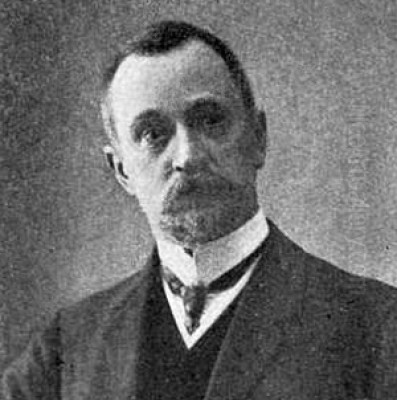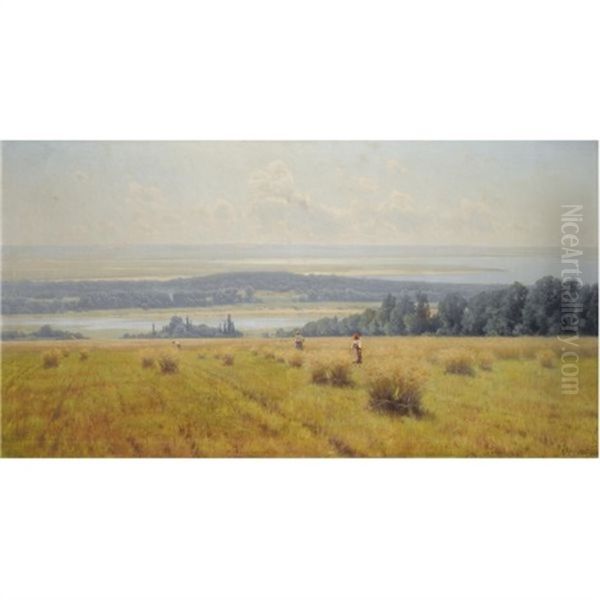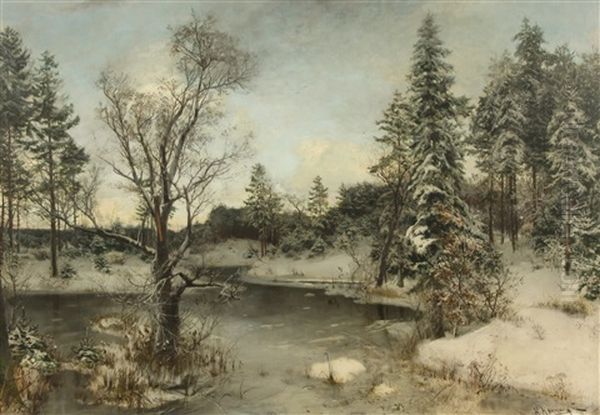
Konstantin Yakovlevich Kryzhitsky stands as a notable, albeit poignant, figure in the annals of Russian art history. A landscape painter of considerable talent and sensitivity, his life was one of artistic dedication, academic achievement, and ultimately, profound personal tragedy. His canvases captured the ephemeral beauty of the Russian and Ukrainian countryside, earning him recognition both at home and abroad. Yet, his career was tragically cut short by a scandal that his sensitive nature could not endure, leaving behind a legacy that invites both admiration for his art and sorrow for his fate. This exploration delves into the life, work, and unfortunate demise of an artist whose paintings continue to resonate with a quiet, lyrical charm.
Early Life and Artistic Awakening in Kyiv
Konstantin Yakovlevich Kryzhitsky was born on May 17, 1858, in Kyiv, then a prominent city within the Russian Empire, now the capital of Ukraine. His early years were spent in this historic city, a place rich in cultural heritage and surrounded by the picturesque landscapes that would later feature prominently in his artistic oeuvre. From a young age, Kryzhitsky displayed a discernible aptitude for the arts, a passion that was nurtured and encouraged.
His formal artistic education commenced at the Kyiv Drawing School, a respected institution that provided foundational training for many aspiring artists in the region. Under the tutelage of figures like Mykola Murashko, who himself was a proponent of realist art and had studied under students of Karl Bryullov, Kryzhitsky would have been exposed to the prevailing artistic currents of the time. This early schooling laid the groundwork for his technical skills and instilled in him a deep appreciation for the meticulous observation of nature, a hallmark that would define his later work. The Ukrainian environment, with its rolling hills, dense forests, and serene rivers, offered ample inspiration for the young artist, shaping his eye for natural beauty and subtle atmospheric effects.
Academic Pursuits at the Imperial Academy of Arts

Driven by ambition and a desire to further hone his craft, Kryzhitsky made the pivotal decision to move to Saint Petersburg, the imperial capital and the epicenter of artistic life in Russia. In 1877, he enrolled in the prestigious Imperial Academy of Arts, one of the most esteemed art institutions in Europe. This was a significant step, placing him in an environment of rigorous academic training and direct contact with leading artists and influential art movements.
At the Academy, Kryzhitsky studied under the guidance of Professor Mikhail Konstantinovich Clodt von Jürgensburg (often referred to as Mikhail Clodt). Clodt was a distinguished landscape painter in his own right, known for his detailed and somewhat austere depictions of the Russian landscape, and a member of the influential Peredvizhniki (Wanderers) society, although his relationship with them was complex. Under Clodt's mentorship, Kryzhitsky refined his technique, mastering the principles of composition, perspective, and the nuanced rendering of light and shadow. The Academy's curriculum emphasized a strong foundation in drawing and a faithful representation of reality, principles that Kryzhitsky absorbed and integrated into his evolving style. His dedication and talent did not go unnoticed.
In 1884, Kryzhitsky graduated from the Imperial Academy of Arts with the title of "First Class Artist," a significant distinction. His graduation piece, the painting titled "Oaks," earned him a gold medal, a testament to his skill and the high regard in which his work was held by the academic authorities. This early success marked his official entry into the professional art world and set the stage for a promising career. Five years later, in 1889, his continued artistic achievements were recognized when he was granted the title of Academician, a prestigious honor that solidified his standing within the Russian art establishment.
The Landscape as Poetic Expression
Konstantin Kryzhitsky dedicated his artistic life primarily to landscape painting. He worked proficiently in oils, watercolors, and pencil, demonstrating versatility across different mediums. His subjects were drawn from the natural environments he knew best: the expansive plains and forests of the Kyiv Governorate and the more subtly charming environs of Saint Petersburg and its surrounding areas. His paintings are characterized by a deep sensitivity to the moods of nature, capturing the changing seasons, the play of light at different times of day, and the unique atmosphere of each locale.

Kryzhitsky's style can be described as naturalistic, with a strong lyrical undercurrent. While he adhered to the academic principles of careful observation and detailed rendering, his works often transcend mere topographical accuracy. They evoke a sense of tranquility, a quiet contemplation of nature's beauty. He was particularly adept at depicting forest scenes, riverbanks, and winter landscapes, imbuing them with a poetic quality that resonated with contemporary audiences. His palette was often subtle, favoring harmonious color schemes that enhanced the atmospheric effects he sought to achieve. Unlike some of his contemporaries who focused on grand, epic vistas, Kryzhitsky often found beauty in more intimate corners of the natural world.
His contemporaries included a constellation of brilliant Russian landscape painters. The towering figure of Ivan Shishkin, known for his meticulous and powerful depictions of Russian forests, set a high bar for technical mastery. Isaac Levitan, a master of the "mood landscape," conveyed profound emotional depth through his evocative scenes. Alexei Savrasov, famous for "The Rooks Have Arrived," brought a new lyricism to Russian landscape painting. Fyodor Vasilyev, a prodigious talent who died young, also created deeply atmospheric works. While Kryzhitsky's style differed from these artists in various respects, he shared with them a profound love for the Russian land and a commitment to capturing its essence on canvas. Other prominent artists of the era, such as Ilya Repin, Vasily Surikov, and Viktor Vasnetsov, though primarily known for historical or genre scenes, were part of the broader artistic milieu that valued national themes and realistic representation.
Notable Works and Artistic Achievements
Throughout his career, Kryzhitsky produced a significant body of work, with several paintings gaining particular acclaim. "Oaks" (1884), his graduation piece, was an early indicator of his talent for depicting the majesty of trees and forest interiors. Another significant work, "Forest" or "Forest Panorama," achieved considerable recognition when it was acquired by Tsar Alexander III. Royal patronage was a significant mark of success for artists of this period, and the Tsar's acquisition underscored Kryzhitsky's growing reputation.
Other notable paintings include "Before Noon," which was exhibited in Germany and later entered a private collection. This work likely captured a specific moment of light and atmosphere, characteristic of his interest in the transient effects of nature. "Green Street" and "Breath of Spring" are titles that suggest his focus on particular seasonal moods and the evocative power of nature's cycles. His landscapes often featured water, whether tranquil rivers or melting snow, reflecting light and adding a dynamic element to his compositions. He was also skilled in watercolor, a medium that allowed for spontaneity and a delicate rendering of light, and he was a founding member of the Russian Society of Watercolorists, actively participating in its activities. This involvement highlights his commitment to promoting this particular medium and fostering a community of artists.
Kryzhitsky's works were regularly featured in academic exhibitions and also gained international exposure. He participated in World Fairs in France and Germany, bringing Russian landscape art to a wider European audience. This international presence was a testament to the quality of his work and its appeal beyond national borders. His paintings were sought after by collectors and found their way into important public collections, including the State Russian Museum in Saint Petersburg, ensuring their preservation and accessibility for future generations.
Involvement in Artistic Societies and the Kuindzhi Legacy
Beyond his personal artistic practice, Konstantin Kryzhitsky was an active participant in the artistic life of Saint Petersburg. His role as one of the first members of the Russian Society of Watercolorists demonstrates his commitment to collaborative artistic endeavors and the promotion of specific art forms. Such societies played a crucial role in the 19th and early 20th-century Russian art world, providing platforms for exhibitions, discussions, and mutual support among artists.
A particularly significant association was his connection to Arkhip Kuindzhi, another highly influential and innovative landscape painter. Kuindzhi, known for his dramatic and almost mystical use of light, was a charismatic figure who inspired many younger artists. After Kuindzhi's death in 1910, a society was formed in his name, funded by a bequest from Kuindzhi himself, to support artists. Kryzhitsky became the chairman of the A.I. Kuindzhi Society. This position of leadership indicates the respect he commanded among his peers and his dedication to preserving Kuindzhi's legacy and supporting fellow artists. This role, however, would soon be overshadowed by the tragic events that were to unfold.
The artistic environment of the time was vibrant but also competitive. Artists like Nikolai Ge, known for his powerful historical and religious paintings, and Ivan Kramskoy, a leading intellectual figure of the Peredvizhniki movement, contributed to a climate of intense artistic debate and development. Vasily Polenov brought a gentle, lyrical quality to his landscapes and genre scenes, while Mikhail Nesterov explored spiritual themes within the Russian landscape. Kryzhitsky navigated this complex world, achieving academic recognition and contributing to its institutional fabric.
The Plagiarism Scandal and Tragic Demise
The final chapter of Konstantin Kryzhitsky's life is marked by a devastating controversy that ultimately led to his tragic end. In 1910 or early 1911, Kryzhitsky faced accusations of plagiarism. The specific claim was that one of his paintings, or a motif within it, bore too close a resemblance to a work by another artist. The provided information identifies this artist as Yakov Brovar, a contemporary. Some art historical accounts suggest the artist in question might have been Yuliy Klever, another popular landscape painter known for his somewhat theatrical sunset scenes, with the alleged plagiarism concerning a motif from Klever's "Red Sunset on the Snow." Regardless of the exact source of the copied work, the accusation itself was profoundly damaging.
In the art world of the time, originality was highly prized, and an accusation of plagiarism could destroy an artist's reputation. The charge against Kryzhitsky, a respected Academician and chairman of the Kuindzhi Society, became a public scandal. Newspapers and art circles buzzed with the news. Kryzhitsky, described as a man of sensitive and vulnerable temperament, was deeply affected by the allegations. He attempted to defend himself, reportedly publishing materials to refute the claims and clear his name. However, the public nature of the scandal and the perceived stain on his honor proved overwhelming.
The pressure and what he felt as "unbearable humiliation" took a severe toll. On April 4, 1911, at the age of 53, Konstantin Yakovlevich Kryzhitsky died in Saint Petersburg. The widely reported cause of his death was suicide, a direct consequence of his inability to cope with the plagiarism accusations and the damage to his reputation. This tragic end sent shockwaves through the artistic community.
It is important to note, as mentioned in the initial information, that some sources or evidence suggest he did not commit suicide due to plagiarism charges. This indicates a potential complexity or differing contemporary accounts surrounding his death. However, the narrative of suicide linked to the plagiarism scandal is the most commonly recounted version in art historical literature and has significantly shaped the perception of his life story. If his death was not a suicide, the alternative cause is not clearly specified in the provided conflicting information, but the shadow of the plagiarism accusation undoubtedly darkened his final year.
Legacy and Reassessment
Konstantin Kryzhitsky's premature and tragic death cut short a career that had already achieved significant recognition. The scandal surrounding his final years inevitably cast a shadow over his legacy for a time. However, with the passage of time, his artistic contributions can be assessed more objectively. His paintings, preserved in museums and private collections, stand as a testament to his skill as a landscape artist.
His works are admired for their technical proficiency, their subtle and poetic rendering of Russian and Ukrainian nature, and their ability to evoke a sense of peace and contemplation. He successfully captured the quiet beauty of the forest, the reflective surfaces of water, and the delicate transitions of the seasons. While perhaps not as revolutionary as some of his contemporaries like Kuindzhi or as epic in scope as Shishkin, Kryzhitsky carved out a distinct niche with his lyrical and meticulously crafted landscapes.
He was part of a generation of Russian artists who sought to define a national school of landscape painting, moving away from purely Italianate or classical ideals towards a deeper engagement with their native environment. His involvement with the Russian Society of Watercolorists and the Kuindzhi Society also speaks to his commitment to the broader artistic community. Artists like Valentin Serov, a brilliant portraitist who also painted landscapes, and Konstantin Korovin, a leading Russian Impressionist, were his contemporaries who pushed Russian art in new directions, but Kryzhitsky's more traditional, academic-grounded lyricism held its own appeal.
Today, Kryzhitsky is remembered as a talented painter whose life ended in tragic circumstances. His art invites viewers to appreciate the serene beauty he found in the natural world, a beauty that he conveyed with sincerity and skill. The circumstances of his death serve as a somber reminder of the pressures faced by artists and the devastating impact that public scandal can have on a sensitive individual. His paintings, however, endure beyond the tragedy, offering a window into the soul of an artist who loved and understood the subtle poetry of the landscape. His contribution to Russian art, though perhaps quieter than some, remains a valuable part of its rich tapestry.